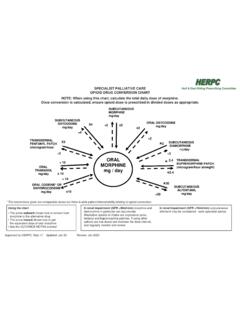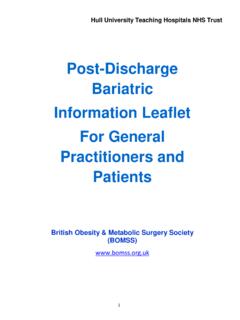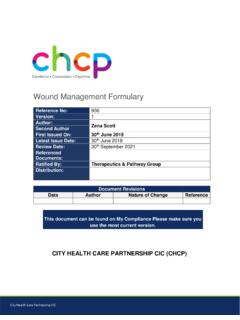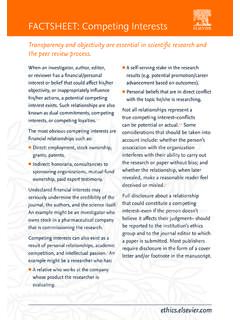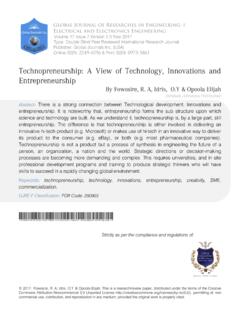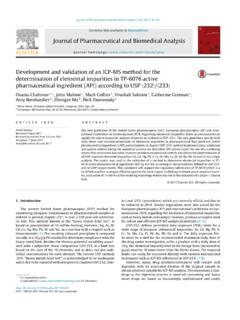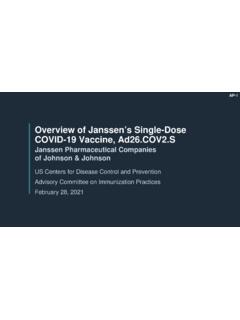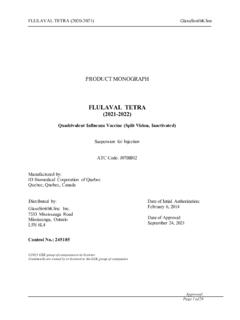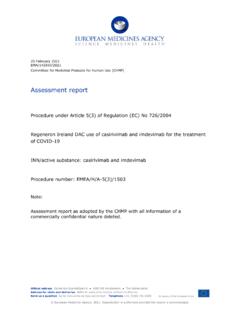Transcription of Management of Parkinson’s in patients with swallowing ...
1 Hull & East Riding Prescribing Committee Management of Parkinson s in patients with swallowing difficulties Approved HERPC Nov 14 Updated: Sept 19 Review: Sept 22 1 of 7 Management of Parkinson s in patients with swallowing difficulties or requiring administration via enteral tube BACKGROUND Parkinson s is a progressive degenerative neurological disorder associated with loss of dopamine producing neurones in the substantia nigra. The cardinal features of Parkinson s are: 1. Slowness of movement 2. Muscle rigidity 3. Tremor 4. Postural instability (not in early stages) Parkinson s is a condition which affects movement and motor function but it is also a condition which causes many non motor symptoms including depression, anxiety and pain.
2 Medication is crucial in optimising Management of Parkinson s and patient s condition will deteriorate significantly if medication cannot be given. This guideline provides information on alternative treatment options and method of administration when a solid oral dosage form cannot be administered via the oral route. PURPOSE The information included in this guideline is adapted from a Hull and East Yorkshire Hospital clinical guideline, and may help with queries arising on transfer of care. It may also be used by non-specialists to support prescribing, dispensing and administration of medicines for Parkinson s in patients with swallowing difficulties, whilst awaiting specialist review. Contact details for further advice Refer to Speech and Language Therapy service for review of swallowing difficulties (GP referral.)
3 See end of document) Speech and Language Therapy Unit 4, Henry Boot Way Priory Park, Hull HU4 7DY Email: Neurology specialist team Parkinson s Specialist Nurse: 01482 676438 Consultant Neurologist as per clinic letter for previous treatment advice Out of hours: contact Neurology registrar via HEY switchboard (01482 875875) Hull & East Riding Prescribing Committee Management of Parkinson s in patients with swallowing difficulties Approved HERPC Nov 14 Updated: Sept 19 Review: Sept 22 2 of 7 OPTIONS FOR ADMINISTRATION OF MEDICINES FOR PARKINSON S IN patients WITH swallowing DIFFICULTIES OR FOR ADMINISTRATION VIA ENTERAL ROUTE The options listed below give alternative formulations or method of administration for patients already prescribed specified treatment for Parkinson s.
4 Crushing of tablets, dispersal of tablets in water (except Madopar dispersible) and administration via enteral tube are all unlicensed indications. Levodopa Co-careldopa (Sinemet / Caramet / generic) standard release preparations will disperse in water in 1-5 minutes for administration down enteral tubes, this must be given immediately as will degrade in the air and settling occurs which can reduce dose administered. Alternatively Sinemet can be converted to Madopar dispersible (as per the table below). See below for CR preparations Co-beneldopa (Madopar) use the dispersible tablets. The capsules should not be opened and must be converted to dispersible tablets. See below for CR preparations.
5 Points to Note when prescribing; Levodopa is mainly absorbed in the jejunum, so effect may be unpredictable when administered NJ (time to onset may be quicker and may need to adjust the dose) Controlled release (CR) preparations cannot be crushed and must be converted to the appropriate standard release preparation (see table below). Dispersed tablets have a quicker onset, higher bioavailability and shorter duration of action so will need to give in two divided doses spaced out evenly. Due higher bioavailability multiply total daily CR levodopa dose by and round to nearest available dispersible preparation Absorption may be altered by enteral feeds, particularly those with higher protein concentration. If poor control o Reducing protein content in enteral feed (diets containing protein are reported to eliminate the problem o Increasing dose of levodopa medication o Withholding feed 1-2 hours either side of levodopa medication administration It may be appropriate to prescribe a small PRN dose of Co-beneldopa dispersible to cover any on-off effects Table 1 Converting from co-careldopa to co-beneldopa Co-careldopa (Sinemet) Co-beneldopa (Madopar) Sinemet 50 ( ) tablet Madopar 50 ( ) dispersible tablet Sinemet 100/10 (110) tablet Madopar 100/25 (125) dispersible tablet Sinemet Plus 100/25 (125) tablet Madopar 100/25 (125) dispersible tablet Sinemet 250/25 (275) tablet 2 x Madopar 100/25 (125))
6 Dispersible tablet Half Sinemet CR 100/25 (125) tablet See text above Sinemet CR 200/50 (250mg) tablet Entacapone and opicapone *this is not an essential medication in the acute situation* Must be given at the same time of day as levodopa containing medication Enteral feeding tubes: The tablet can be dispersed in water for administration in 1-5 minutes. Dispersal may not be complete, so will need to flush the tube well. Note this may stain the feeding tube orange. Crushing may produce a red dust which may stain. swallowing difficultites: Tablet can be crushed but has bitter taste, mixing with jam, honey or orange juice may help Hull & East Riding Prescribing Committee Management of Parkinson s in patients with swallowing difficulties Approved HERPC Nov 14 Updated: Sept 19 Review: Sept 22 3 of 7 There is no information relating to crushing opicapone for enteral feeding tubes or for swallowing difficulties.
7 Sastravi / Stalevo Combination product containing levodopa, carbidopa and entacapone Enteral feeding tubes: First line: convert to co-beneldopa dispersible tablets plus entacapone and give as described above. See table below for advice on dose conversion on co-beneldopa. Second line: crush the tablet, although this is from anecdotal information, dosage adjustment may be required. swallowing difficulties: First line: convert to co-beneldopa dispersible tablets plus entacapone and give as described above. Second line: Tablet can be crushed but has bitter taste, mixing with jam, honey or orange juice may help Table 2: Stalevo to co-beneldopa plus entacapone Sastravi/Stalevo strength Levodopa Carbidopa Entacapone Conversion doses Co-beneldopa Entacapone 50 50 200 200 75 75 200 200 100/25/200 100 25 200 1x125 200 125 125 200 1x125 plus 200 150 150 200 1x125 plus 200 175 175 200 1x125 plus 200 200/50/200 200 50 200 2x125 200 Ropinirole and pramiprexole Enteral feeding tubes: ropinirole tablets disperse in 10ml water, best with food/NG feed to improve tolerability.
8 Pramiprexole tablets can be crushed and mixed with water. swallowing difficulties: ropinirole tablets can be crushed and mixed with soft food (ensure food is eaten). Pramiprexole tablets can be crushed and mixed with water. Both agents come as modified release (MR) preparations which cannot go down enteral feeding tubes or be crushed for patients with swallowing difficulties. If the patient is usually on an MR preparation the daily dose must be divided by three and given every 8 hours (eg ropinirole MR 6mg OD should be converted to standard release 2mg TDS) Pramipexole can be prescribed both in terms of salt or base. Please ensure prescribed clearly. See below for clarification.
9 For normal release tablets 88 micrograms base 125 micrograms salt; 180 micrograms base 250 micrograms salt; 350 micrograms base 500 micrograms salt; 700 micrograms base 1 mg salt For MR tablets 260 micrograms base 375 micrograms salt; 520 micrograms base 750 micrograms salt; mg base mg salt; mg base mg salt; mg base 3 mg salt; mg base mg salt; mg base mg salt. Hull & East Riding Prescribing Committee Management of Parkinson s in patients with swallowing difficulties Approved HERPC Nov 14 Updated: Sept 19 Review: Sept 22 4 of 7 Selegiline,rasagiline and safinamide *Not clinically urgent in acute situation* Enteral feeding tubes: first line: selegiline use liquid and dilute with equal volume of water, second line crush tablets and disperse in water.
10 Rasagline crush tablets and disperse in water. Selegiline oral lyophilisate is not suitable for crushing via enteral feeding tubes is equivalent to 10mg oral selegiline therefore convert to oral selegiline until safe to use. There is no information on crushing safinamide. swallowing difficulties: first line: selegiline oral lyophilisate if patient able (tablet placed on tongue and disperses within 10 seconds patient cannot drink, eat or rinse mouth out for 5 minutes after taking). Need moist mouth and be able to use an oral lyophilisate some oral mucosal absorption. If unable to use oral lyophilisate selegiline liquid. Rasagiline crush tablet and disperse in water, tablets are tasteless. There is no information on crushing safinamide.
